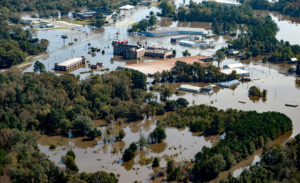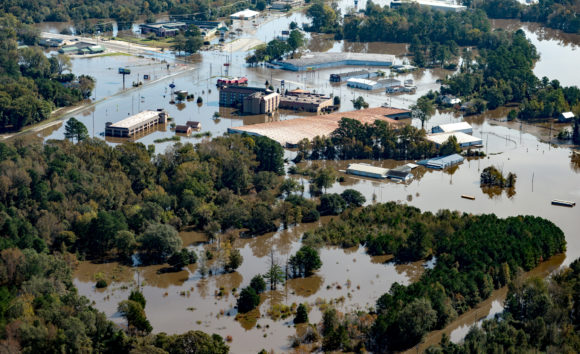It is fair to say 2016 was the year of the catastrophe in the Southeast. Tornadoes, drought, floods, hurricanes, and wildfires impacted virtually every state in the region.
For the insurance industry, these events made for a very busy year but experts say they will have little long-term impact on the Southeast and its underwriting results.
The year started off with multiple tornadoes rolling across Alabama, Florida and Mississippi in February; severe flooding occurred in Mississippi in March, followed by damaging hail and wind storms.
In June, West Virginia was also hit by severe flood that destroyed at least 1,500 homes, damaged 4,000 others, caused $36 million in damage to roads, and killed at least 23 people.
September and October saw the first major hurricanes to affect Florida in 11 years – Hurricane Hermine and Hurricane Matthew – which caused extensive property damage and flooding. The storms also impacted policyholders in Georgia, South Carolina and North Carolina.

Major rainfall in North Carolina from Hurricane Matthew led to severe flooding and damage to more than 78,000 homes and residential structures, and caused 28 deaths. About 30,000 businesses in the state were affected by the floods and crop losses totaled more than $400 million. The state estimated the economic damage because of business interruption losses at $2 billion.
Property/casualty insurer claim payouts from Matthew totaled more than $800 million in Florida alone, according to the Florida Office of Insurance Regulation. Swiss Re pegged the total U.S. insured losses from Hurricane Matthew at $4 billion.
Meanwhile, what seemed to be a never-ending drought plagued most of the Southeast region throughout the year. Conditions were particularly dry in Georgia, Alabama and Tennessee, as well as in western North and South Carolina. The lack of rain wreaked havoc on the region’s agricultural industries while at the same time created the perfect conditions for inferno-like wildfires in Alabama, the Carolina’s and Tennessee.
One such wildfire that began in Tennessee’s Great Smoky Mountains ripped through the tourist town of Gatlinburg, home of Dolly Parton’s Dollywood, on Nov. 28. The fire killed 14 people and caused at least $500 million in damage.
The year finished off its major Southeast catastrophes with about 20 tornadoes in Alabama at the end of November.
“It has been a tough year for the Southeast,” said Bill Gatewood, corporate vice president and director, Personal Insurance, for Burns & Wilcox in Farmington Hills, Mich.
While the region is no stranger to facing extreme weather events, the frequency and severity with which they occurred in 2016 was unusual, insurance experts say. In particular, the wildfires that occurred in the latter part of the year are not a common occurrence in the area, and some questioned if state’s like Tennessee are prepared to handle them.
“As bad as hurricanes can be they are predictable, you see them coming and you know if you are in the path. With wildfires you don’t get the same level of predictability,” said Gatewood. “The wind can shift and the fire goes in another direction. They are more unpredictable and catch people off guard.”
Barry L. Whitton, managing director of Burns & Wilcox Brokerage in Atlanta, said the area has been spared from devastating events like fire and hurricanes in recent years, causing many residents to become complacent.
“In our area hurricanes are the predominant cat loss we see and we just haven’t had those events for a number of years,” he said. “Wildfires are something we see on the news happening in the West – we don’t have that significant issue here… we are not set to handle those types of things as much as the western states.”
Bill Sager, executive vice president of the Alabama Independent Insurance Agents Association, agrees.
“My guess is there probably hasn’t been as much conversation for wildfire awareness as tornado or hurricane awareness. I would not think there would have been the same level of concern about [fires] as there has been about the other [catastrophes],” Sager said.
The insurance industry, however, was prepared to pay the losses from Southeast claims related to these events. Despite North America being hit by more natural disasters in 2016 than any year since 1980, with overall losses totaling $10.2 billion, according to Munich Re, the experts said there will be little effect on the Southeast insurance market.
“In the big picture, there is so much surplus capital in the industry right now that Hurricane Matthew and wildfires are in the normal course of losses and won’t have a significant impact on the industry,” said Gatewood. “We are at a place where there is so much excess capital it would take a significant number of catastrophes to really impact pricing.”
Russ Dubisky, executive director of the South Carolina Insurance Association, said the claims activity was certainly busier than in years past with more activity “in the last three months than in the last three years on average.”
“I wouldn’t say that it’s typical but I remind folks that in a state like South Carolina we are susceptible to every natural disaster known to man with the exception of volcanoes,” Dubisky said.
He added, though, that none of these events will change the soft market. “It’s a buyer’s market, if you will. It’s very competitive out there.”
In the immediate aftermath of each event, the industry did everything it could do to respond quickly and efficiently to its affected customers, he said.
“Almost every disaster we have seen the [state] Department of Insurance was very quick to authorize the use of temporary adjusters in the state and many companies took advantage of that and brought in additional adjusters to get claims handled as quickly as possible,” Dubisky said. “The response was basically immediate from the insurance industry.”
That being said, each event offers the industry a chance do better next time.
“You always learn from something every time you go through it,” Dubisky said.
Gatewood said many of the wildfires happened in rural areas where people have second homes that were either underinsured or uninsured. The wildfires are a lesson for many residents in the region to make sure they have adequate coverage.
“This is a good opportunity to remind people that having proper insurance is important – especially for cat losses like this. This is really what insurance is for… it is here to protect you in the event you lose everything,” he said.
Whitton said these disasters also offer an opportunity for agents to really partner with their clients.
“We need to hold our clients hand and make sure they know what’s going on and reach out to customers. [Agents] need to be readily available to assist them,” he said.
Sager said the events like wildfires could bring a new awareness from municipalities on the importance of preparation to reduce or eliminate the amount of damage.
“That awareness is a good thing,” he said.
Sager said that although he doesn’t expect any drastic changes on the underwriting side, he believes carriers will likely step back and take a look at their books of business and underwriting guidelines in the region. He hopes that will be in a positive format of “how do we minimize these things if they happen again?”
To that end, Southeast agents should remain vigilant when it comes to working with their carriers.
“We encourage our members to stay engaged with their carriers and stay informed, if they can, on what changes they are considering,” he said. “Be in touch and know what is happening on the carrier side so you can work together to put business on the books.”
Topics Florida Catastrophe Natural Disasters Agencies Windstorm Wildfire Flood Alabama Hurricane Market Tennessee South Carolina
Was this article valuable?
Here are more articles you may enjoy.



 JPMorgan Client Who Lost $50 Million Fortune Faces Court Setback
JPMorgan Client Who Lost $50 Million Fortune Faces Court Setback  Allstate Reports $731M in Q1 Pretax Catastrophe Losses
Allstate Reports $731M in Q1 Pretax Catastrophe Losses  Cargo Owners in Baltimore Disaster Face ‘General Average’ Loss Sharing, MSC Says
Cargo Owners in Baltimore Disaster Face ‘General Average’ Loss Sharing, MSC Says  Survey Shows Majority of Florida, California Homeowners Seeing Higher Insurance Costs
Survey Shows Majority of Florida, California Homeowners Seeing Higher Insurance Costs 

